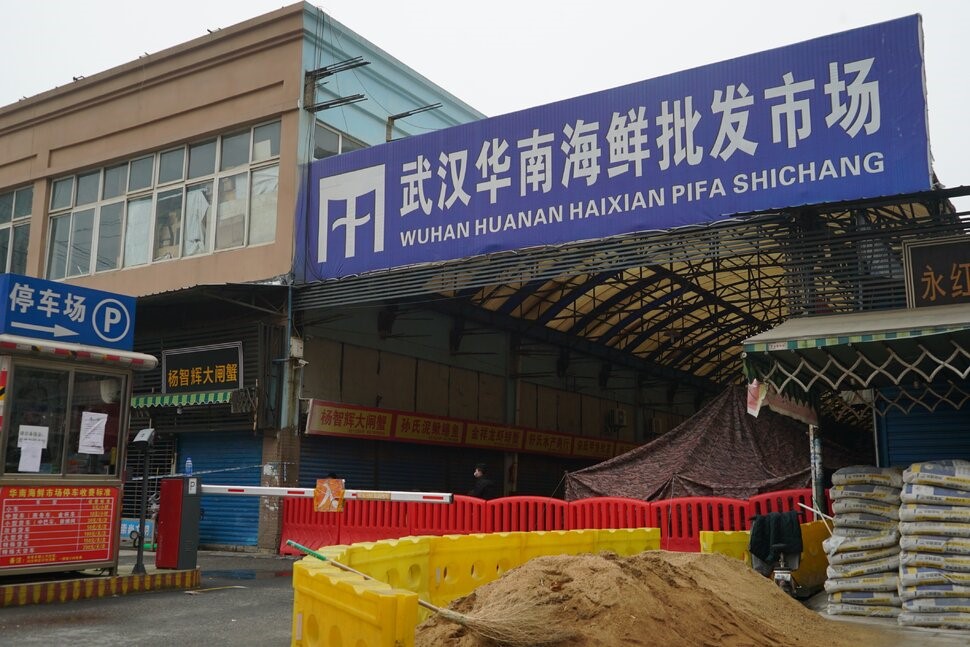March 2, 2022
According to a February 28, 2022 recent article n U.S. News World based on several studies, the research is suggestive that the Wuhan China wet market was the start of the COVID-19 pandemic. The article is largely based on two pre-print studies, meaning neither study has been peer-reviewed and formally published. The Worobey pre-print article (2022) findings suggested that using geospatial analyses that two early lineages of the Sars-Cov-2 virus was clearly associated with the Huanan Seafood Market and goes on to add that no other hypothesized origin narrative is supported by the data. The authors cite their table 1 of median distances and centroids with several p-values but do not list anywhere what statistical test was used except this buried within their methods section in the supplement, “Significance testing of the distance between the December centroids and the Huanan market compared to the null distributions was based on random samples (with replacement) of 1,000 points from the population density data (weighted) or the Weibo data (3), to represent plausible starting point of the COVID-19 epidemic in Wuhan, insofar as the centroid of early cases might reflect the starting point of the epidemic.” They then go on to state how they computed the median distance and the centroid distance to the Huanan market for each iteration, then compared their average across all iterations to the null distributions drawn from the Weibo cases and worldpop.org samples. They then somehow computed the range of P-values for comparing the metrics at each iteration to the null distributions. The authors should better explain their use of these methods, whether Monte Carlo sampling or other, in the article if they seek to have it fully published.
In the second paper discussed in this article, it is another pre-print article by Pekar et al (2002), where the authors used haplotype analyses to infer the ancestral SARS-CoV-2 haplotype. They then state that they developed and implemented a novel non-reversible, random-effects substitution process model in a Bayesian phylodynamic framework which as they state simultaneously reconstructs the underlying coalescent processes and the sequence of the MRCA of the SARS-CoV-2 phylogeny. They referred to this model as the unconstrained model. They then obtained Bayes Factors from this analyses and looked at haplotypes with the greatest posterior probability to assess the lineages of the virus. They did find that the ancestral haplotypes for both lineages A and B had persisted during the early months of the pandemic which as they said were reminiscent of successful introductions of SARS-CoV-2 into locations outside China early in the pandemic Their conclusions are that the empirical genomic data is best explained by at least two distinct zoonotic transmissions, whereby lineage A and B viruses both circulated in a non-human host of unknown origin, however their link from their analyses is difficult to distill.
Whether or not all of this is convincing enough data from these two studies, the origin is still yet to be truly discovered. With evidence potentially destroyed or gone, it has proven difficult to ascertain. These studies are not peer-reviewed and the article does state that so at this time their evidence should only be considered but taken at full value without thorough review. Also statistically, their methods for estimation are difficult to understand as currently explained. Hopefully these methods will be reviewed carefully.
Written by,
Usha Govindarajulu
Keywords:
COVID-19, Wuhan, biostatistics, Monte Carlo, Bayesian
References
Smith-Schoenwalder S (Feb 28, 2022) “New Research Suggests Wuhan Market Was COVID-19 Pandemic Epicenter” U.S. News & World Report, https://www.usnews.com/news/health-news/articles/2022-02-28/new-research-suggests-wuhan-market-was-covid-19-pandemic-epicenter
Worobey M, Levy JI, Serrano LMM , Crits-Christoph A, Pekar JE, Goldstein SA, Rasmussen AL, Kraemer MUG, Newman C, Koopmans MPG, Suchard MA, Wertheim JO, Lemey P, Robertson DL, Garry RF, Holmes EC, Rambaut A, and Andersen KG. (2022). “The Huanan market was the epicenter of SARS-CoV-2 emergence” https://zenodo.org/record/6299600#.Yh6iSf7MJaS
Pekar, Jonathan E., Magee, Andrew, Parker, Edyth, Moshiri, Niema, Izhikevich, Katherine, Havens, Jennifer L., Gangavarapu, Karthik, Malpica Serrano, Lorena M., Crits-Christoph, Alexander, Matteson, Nathaniel L., Zeller, Mark, Levy, Joshua I., Wang, Jade C., Hughes, Scott, Lee, Jungmin, Park, Heedo, Park, Man-Seong, Ching Zi Yan, Katherine, Tzer Pin Lin, Raymond, … Wertheim, Joel O. (2022). “SARS-CoV-2 emergence very likely resulted from at least two zoonotic events”. Zenodo. https://doi.org/10.5281/zenodo.6291628
https://www.usnews.com/dims4/USNEWS/b51d8ab/2147483647/thumbnail/970×647/quality/85/?url=http%3A%2F%2Fmedia.beam.usnews.com%2F78%2Fcd%2Febd7574d4826a9cbbc765f0f292f%2Fap21021845208360.jpg
